Period 1910 – 1911 | ||
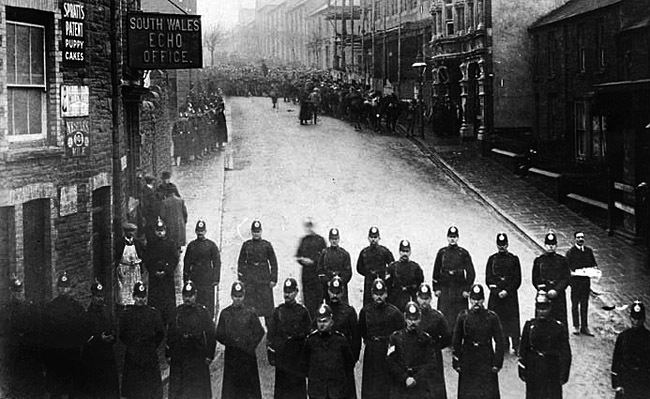 | ||
Tom tonypandy riots
The Tonypandy riots of 1910 and 1911 (sometimes collectively known as the Rhondda riots) was a series of violent confrontations between coal miners and police that took place at various locations in and around the Rhondda mines of the Cambrian Combine, a cartel of mining companies formed to regulate prices and wages in South Wales. The riots were the culmination of an industrial dispute between workers and the mine owners. The term "Tonypandy riot" initially applied to specific events on the evening of Tuesday 8 November 1910, when strikers, impassioned by extended hand-to-hand fighting with the Glamorgan Constabulary, reinforced by the Bristol City Constabulary, smashed windows of businesses in Tonypandy.
Contents
- Tom tonypandy riots
- Tonypandy riots 1
- Background
- The riots at Tonypandy
- Reaction to the riots
- Criticism of Churchill
- References
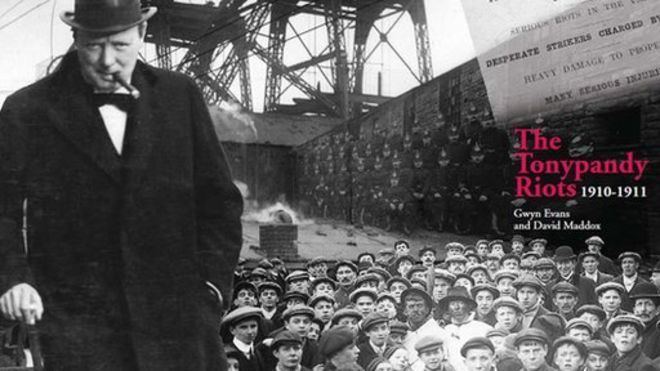
Home Secretary Winston Churchill's decision to allow the British Army to be sent to the area to reinforce the police shortly after 8 November riot caused much ill feeling towards him in South Wales. His responsibility remains a strongly disputed topic.
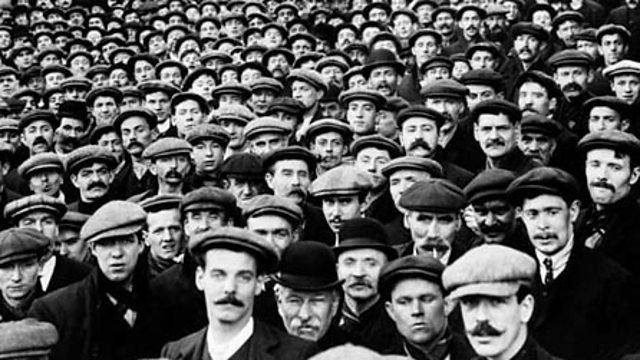
Tonypandy riots 1
Background
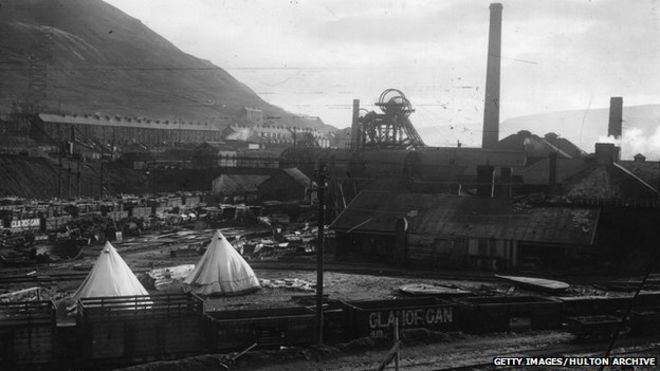
The conflict arose when the Naval Colliery Company opened a new coal seam at the Ely Pit in Penygraig. After a short test period to determine what would be the future rate of extraction, owners claimed that the miners deliberately worked more slowly than they could. The roughly 70 miners at the seam argued that the new seam was more difficult to work than others, due to a stone band that ran through it. Also, since the miners were paid by the ton of coal removed, not by hours of work, working slowly would gain them no advantage.
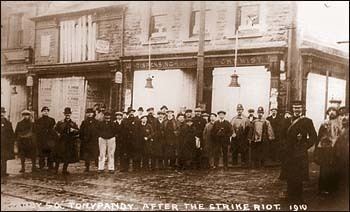
On 1 September 1910, the owners posted a lock-out notice at the mine, closing the site to all 950 workers, not just the 70 at the newly opened Bute seam. The Ely pit miners reacted by going on strike. The Cambrian Combine then called in strikebreakers from outside the area, to which the miners responded by picketing the work site. On 1 November, the miners of the South Wales coalfield were balloted for strike action by the South Wales Miners' Federation, resulting in the 12,000 men working for the mines owned by the Cambrian Combine going on strike. A Conciliation Board was formed to reach an agreement, with William Abraham acting on behalf of the miners and F. L. Davis for the owners. Although an agreed wage of 2s 3d per ton was arrived at, the Cambrian Combine workmen rejected the agreement.

On 2 November, the authorities in south Wales were enquiring about the procedure for requesting military aid, in the event of disturbances caused by the striking miners. The Glamorgan Constabulary resources were stretched, as in addition to the Cambrian Combine dispute, there was a month-old strike in the neighbouring Cynon Valley; and the Chief Constable of Glamorgan had by Sunday 6 November assembled 200 imported police in the Tonypandy area.
The riots at Tonypandy
By this time, strikers had successfully shut down all local pits, except Llwynypia colliery. On 6 November, miners became aware of the owners' intention to deploy strikebreakers, to keep pumps and ventilation going at the Glamorgan Colliery in Llwynypia. On Monday 7 November, strikers surrounded and picketed the Glamorgan Colliery, to prevent such workers from entering. This resulted in sharp skirmishes with police officers posted inside the site. Although miner leaders called for calm, a small group of strikers began stoning the pump-house. A portion of the wooden fence surrounding the site was torn down. Hand-to-hand fighting ensued between miners and police. After repeated baton charges, police drove strikers back towards Tonypandy Square, just after midnight. Between one and two a.m. of 8 November, a demonstration at Tonypandy Square was dispersed by Cardiff police using truncheons, resulting in casualties on both sides. This led Glamorgan's chief constable, Lionel Lindsay, supported by the general manager of the Cambrian Combine, to request military support from the War Office.
Home Secretary Winston Churchill learned of this development and, after discussions with the War Office, delayed action on the request. Churchill felt that the local authorities were over-reacting, and believed that the Liberal government could calm matters down. He instead despatched Metropolitan police officers, both on foot and mounted, and sent some cavalry troops to Cardiff. He did not specifically deploy cavalry, but authorised their use by civil authorities, if deemed necessary. Churchill's personal message to strikers was, "We are holding back the soldiers for the present and sending only police." Despite this assurance, the local stipendiary magistrate telegrammed London later that day and requested military support, which the Home Office authorised. Troops were deployed after the skirmish at the Glamorgan Colliery on 7 November, but before rioting on the evening of 8 November.
During the evening of rioting, properties in Tonypandy were damaged and some looting took place. Shops were smashed systematically, but not indiscriminately. There was little looting, but some rioters wore clothes taken from the shops and paraded in a festival atmosphere. Women and children were involved in considerable numbers, as they had been outside the Glamorgan colliery. No police were seen at the town square, until the Metropolitan Police arrived around 10:30 pm, almost three hours after the rioting began, when the disturbance subsided of its own accord. A few shops remained untouched, notably that of chemist Willie Llewellyn, rumoured to have been spared because he had been a famous Welsh international rugby footballer.
A small police presence might have deterred window-breakages, but police had been moved from the streets to protect the residences of mine owners and managers.
At 1:20 am on 9 November, orders were sent to Colonel Currey at Cardiff, to despatch a squadron of the 18th Hussars to reach Pontypridd at 8:15 am. Upon arrival, one contingent patrolled Aberaman and another was sent to Llwynypia, where it patrolled all day. Returning to Pontypridd at night, the troops arrived at Porth as a disturbance was breaking out, and maintained order until the arrival of the Metropolitan Police. Although no authentic record exists of casualties, since many miners would have refused treatment, from fear of prosecution for their part in the riots, nearly 80 police and over 500 citizens were injured. One miner, Samuel Rhys, died of head injuries, said to have been inflicted by a policeman's baton. Authorities had reinforced the town with 400 policemen, one company of the Lancashire Fusiliers, billeted at Llwynypia, and the squadron of the 18th Hussars.
Thirteen miners from Gilfach Goch were arrested and prosecuted for their part in the unrest. The trial of the thirteen occupied six days in December. During the trial, they were supported by marches and demonstrations by up to 10,000 men, who were refused entry to the town. Custodial terms of two to six weeks were issued to some of the respondents; others were discharged or fined.
Reaction to the riots
Purported eyewitness accounts of alleged shootings persisted and were relayed by word of mouth. There are no records of any shots being fired by troops. The only recorded death was Samuel Rhys. In the autobiographical 'documentary novel' Cwmardy, contemporary communist trade union organiser Lewis Jones presents a stylistically romantic, but closely detailed, account of the riots and their agonising domestic and social consequences. In the chapter Soldiers are sent to the Valley, he narrates a fictional incident, in which eleven strikers are killed by two volleys of rifle fire in the town square, after which the miners adopt a grimly retaliatory stance. In this account, the end of the strike is hastened by organised terror directed at mine managers, leading to introduction of a minimum-wage act by the government – hailed as a victory by the strikers.
A more official version states that "The strike finally ended in August 1911, with the workers forced to accept the 2s 3d per ton negotiated by William Abraham MP prior to the strike ... the workers actually returning to work on the first Monday in September", ten months after the strike began and twelve months after the lock-out which started the confrontation.
Criticism of Churchill
Churchill's role in the events at Tonypandy during the conflict left a negative attitude towards him in South Wales, that still persists today. The main point of contention was his decision to allow troops to be sent to Wales. Although this was an unusual move, and was seen by those in Wales as an over-reaction, his Tory opponents suggested that he should have acted with greater vigour. The troops acted more circumspectly and were commanded with more common sense than the police, whose role under Lionel Lindsay was, in the words of historian David Smith, "more like an army of occupation". The troops were also generally viewed with less hostility than the local and Metropolitan police.
Despite these facts, the incident continued to haunt Churchill through his career. Such was the strength of feeling, that almost forty years later, when speaking in Cardiff during the General Election campaign of 1950, Churchill was forced to address the issue, stating: "When I was Home Secretary in 1910, I had a great horror and fear of having to become responsible for the military firing on a crowd of rioters and strikers. Also, I was always in sympathy with the miners..."
A major factor in the dislike of Churchill's use of the military, was not in any specific action undertaken by the troops, but the fact that their presence prevented any strike action which might have ended the strike early in the miners' favour. The troops also ensured that trials of rioters, strikers and miner leaders would take place and be successfully prosecuted in Pontypridd in 1911. The defeat of the miners in 1911 was, in the eyes of the local community, a direct consequence of state intervention without any negotiation, and this action was seen as a direct result of Churchill's actions. In 2010, 99 years after the riots, a Welsh local council made objections to a street being named after Churchill in the Vale of Glamorgan, because of his sending troops into the Rhondda.
Political fallout for Churchill also continued. In 1940, when Chamberlain's war-time government was faltering, Clement Attlee secretly warned that the Labour Party might not follow Churchill, because of his association with Tonypandy. In 1978, there was uproar in the House of Commons, when Churchill's grandson, also Winston Churchill, replying to a routine question on miners' pay, was warned by James Callaghan not to pursue "the vendetta of your family against the miners of Tonypandy".
